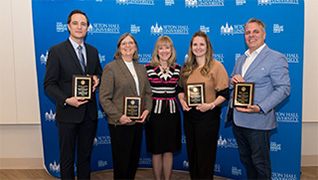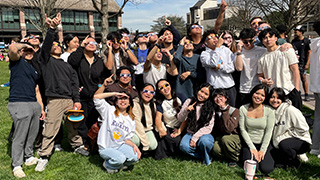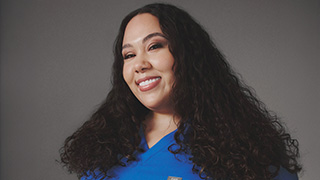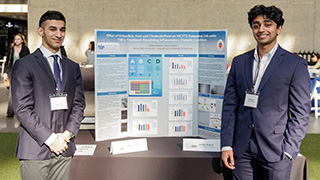Seton Hall's Healthcare Students Team Up for Success
Wednesday, February 14, 2024
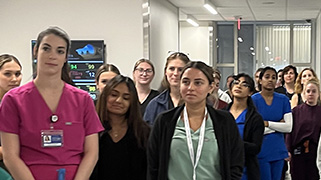
First year students in Seton Hall’s Master of Physician Assistant program tour the simulation facilities at the Interprofessional Health Sciences (IHS) campus.
Seton Hall’s M.S. in Physician Assistant (PA) and M.S. in Speech-Language Pathology (SLP) programs recently hosted a simulation event for their first-year graduate students to practice and develop critical interprofessional clinical evaluation skills. As an SLP student, I found myself immersed in an atmosphere of collaboration and shared knowledge, ready to engage with students from the physician assistant program.
The simulated classroom activity took place at the Interprofessional Health Sciences (IHS) campus, home to Seton Hall’s School of Health and Medical Sciences and College of Nursing. Faculty members grouped SLP and PA students together to tackle a challenging simulated case study involving a pediatric patient with complex communication and medical needs. Our goal: develop a comprehensive plan for the child in the case study that would seamlessly integrate the expertise of both professions.
"The purpose of this Interprofessional Education (IPE) activity was to help PA and SLP students understand each other's roles, gain knowledge of when to refer to each other, clinically problem-solve together, and learn to identify children who are not meeting developmental milestones," said Michelle McWeeney, assistant professor in the department of physician assistant.
Jennifer McCarthy, director of clinical simulation, Seton Hall School of Health and Medical Sciences noted, "Our faculty start building students’ competence in teamwork and patient-centered care from day one. Events like this are the cornerstone, helping Seton Hall students train for success in higher-stakes simulation experiences to come."
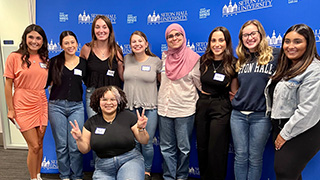
First year students in Seton Hall’s Master of Speech-Language Pathology program.
In my group, we quickly discovered the unique strengths and perspectives each discipline brought to the table. The PA students delved into the medical aspects of the case, examining the child's overall health, medications, and potential underlying medical conditions. Simultaneously, the SLP students, including myself, focused on the child's communication abilities and language development milestones.
What struck me the most was that our collaboration allowed us to gather the most accurate and comprehensive information. As SLP students, we understood the nuances of communication disorders, while the PA students provided crucial insights into the broader medical context. Together, we synthesized our knowledge to paint a holistic picture of the child's needs.
Throughout our discussions, we explored how our respective roles complemented each other, highlighting the importance of effective communication and shared decision-making. We brainstormed on how to administer the most relevant tests, interpret results collaboratively, and ultimately arrived at a precise diagnosis.
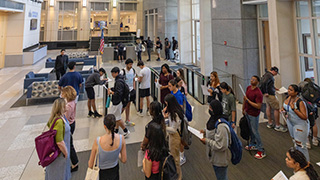
The Winter Garden Atrium at the IHS campus, home to Seton Hall’s School of Health and Medical Sciences and College of Nursing.
As the day progressed, our collaboration extended beyond diagnosis. We delved into the development of an efficient treatment plan for the child, considering both medical interventions and speech-language interventions. The collaboration between our two professions was an eye-opening experience to me, emphasizing the importance of an integrated health care approach.
This interprofessional event not only broadened our knowledge but also laid the foundation for future collaboration. As future SLPs and PAs, we recognized the value of working together to achieve better patient outcomes. The experience served as a testament to the idea that health care is a team effort, where each member brings a unique set of skills that, when combined, create a more comprehensive and effective approach to patient care.
I was grateful for the opportunity to collaborate with Seton Hall’s PA students. This interprofessional experience provided a glimpse into the interconnected nature of health care, preparing us for the real-world situations we will face in our professional careers. I left the event inspired and equipped with a newfound appreciation for collaborative care, knowing that this valuable lesson would stay with me throughout my journey as a speech-language pathologist.
Faculty leads for the simulated case study included Megan Baumley, M.S., CCC-SLP; Christine Fernandez M.D.; Michelle McWeeney Ph.D., PA-C; Abby Saunders Ph.D., PA-C. Additional faculty participation included Tiffany Fiore, PA-C.
Categories: Education, Health and Medicine, Science and Technology

